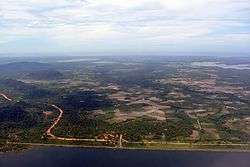Agriculture in Sri Lanka
The primary form of agriculture in Sri Lanka is rice production. Rice is cultivated during Maha and Yala seasons. Tea is cultivated in the central highlands and is a major source of foreign exchange. Vegetables, fruits and oilseed crops are also cultivated in the country. There are two Agriculture Parks abbreviated as A.Parks established by the Department of Agriculture. Out of the total population in Sri Lanka, 31.8% engages in agricultural activities. Agriculture and allied sectors like forestry and fisheries accounted for 18% of the GDP (gross domestic product) in 2014, about 26.4% of the workforce or employment.

Rice cultivation in Sri Lanka
Tea plantations

As an attempt to recuperate the losses caused by the downfall of coffee plantation (such as 1869 Hemileia vastatrix disease and the drooping prices of coffee cultivatable lands during 1847), Tea was planted in Sri Lanka as an experimental crop. Several research groups were sent to Assam to study and identify the necessary prerequisites for the new crop. In between this tea industry was introduced to the country in 1867 by James Taylor, the British planter who arrived in 1852, in Lool Kandura. It is one of the main sources of foreign exchange for Sri Lanka and accounts for 2% of GDP, generating roughly $700 million annually to the economy of Sri Lanka. It employs, directly or indirectly over 1 million people, and in 1995 directly employed 215,338 on tea plantations and estates. Sri Lanka is the world's fourth largest producer of tea. In 1995, it was the world's leading exporter of tea, (rather than producer) with 23% of the total world export, but it has since been surpassed by Kenya.
The humidity, cool temperatures, and rainfall in the country's central highlands provide a climate that favors the production of high quality tea.[2][3][4]
The major tea growing areas are Kandy and Nuwara Eliya in Central Province, Badulla, Bandarawela and Haputale in Uva Province, Galle, Matara and Mulkirigala in Southern Province, and Ratnapura and Kegalle in Sabaragamuwa Province.
Fruits and vegetables
Around eighty different varieties of fruits and vegetables are grown in Sri Lanka's varied agro-climatic areas. The cool and salubrious climatic conditions in the hill country are ideal for temperate crops such as carrot, leek, cabbage, cauliflower, salad leaves, beet, bean, bell pepper, and salad cucumber. The well-demarcated low country and dry wet areas are suitable for a variety of tropical fruits and vegetables ranging from green chilli, red onion, pumpkin, bitter gourd, melon, sweet and sour banana types, queen pineapple, papaya, mango, lemon and gherkins.
Certain indigenous yams colloquially named innala (Lecranthus) and kiri ala (Xanthasoma sagittifolium), underwater stems of kohila (Lasia spinosa) and nelum ala (Nymphea lotus) and fruits and pods of perennial crops such as bread fruit, young jak and murunga are foreign exchange spinners of the country. It is the same with special flavored Sri Lankan pineapple, mangosteen, ripe jak, avocado, rambutan, starfruit and anoda.
Sri Lanka produces more than 800,000 metric tons of fruits and vegetables annually and exports both fresh and processed varieties to many destinations in the world. 90 per cent of the fresh product is targeted to the Middle East and the Maldives and almost about 75 percent of the processed products go to the European market.[5]
Currently Sri Lanka is looking to obtain arid-climate-resistant fruit species from Egypt to develop agriculture in the dry zones of Sri Lanka.[6]
Oilseed crops
Oilseed crops such as groundnut, sesame, sunflower and mustard are also cultivated in Sri Lanka. Groundnut is grown mainly in Moneragala, Hambantota, Kurunegala, Anuradhapura, Badulla, Ratnapura and Puttalam districts. Though groundnut is an oil crop, it has a demand as a snack and confectionery in Sri Lanka.[7]
Agrotechnology parks
Sri Lanka's first agrotechnology park was established in Kandy district. The park is bounded on three sides by the river Mahaweli in the historically important place of Gannoruwa in Kandy and lies at an altitude of 473 m (1550 ft) above sea level in a total area of two square kilometers. The second agrotechnology park was established in Hambantota district adjoining the government farm in Batatha.[8]
Development issues
According to the World Bank:[9]
- Weaknesses in strategy and policy
- Heavy public sector regulatory interventions in commodity and input/factor markets
- Weak delivery of services in rural areas
- Destructive impact of civil conflict and tsunami
See also
References
- "RICE". doa.gov.lk. Retrieved 27 November 2013.
- "Sri Lanka tops tea sales". BBC. 1 February 2002.
- "Role of Tea in Development in Sri Lanka". United Nations Economic and Social Commission for Asia and the Pacific. Archived from the original on 6 October 2008.
- "South Asia Help for Sri Lanka's tea industry". BBC News. 4 April 1999.
- "Fruits and Vegetables". srilankabusiness.com. Retrieved 27 November 2013.
- "Sri Lanka to obtain arid climate resistant fruit species from Egypt". Lanka Business Online. Retrieved 29 October 2015.
- "Groundnuts". Retrieved 27 November 2013.
- "Agriculture Technology Parks". doa.gov.lk. Retrieved 27 November 2013.
- "Sri Lanka: Priorities for Agriculture and Rural Development". World Bank.